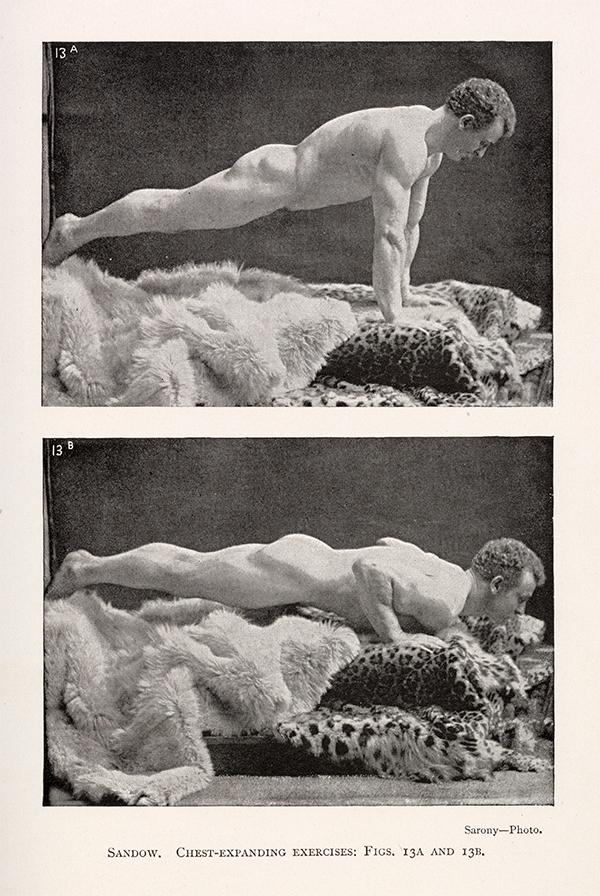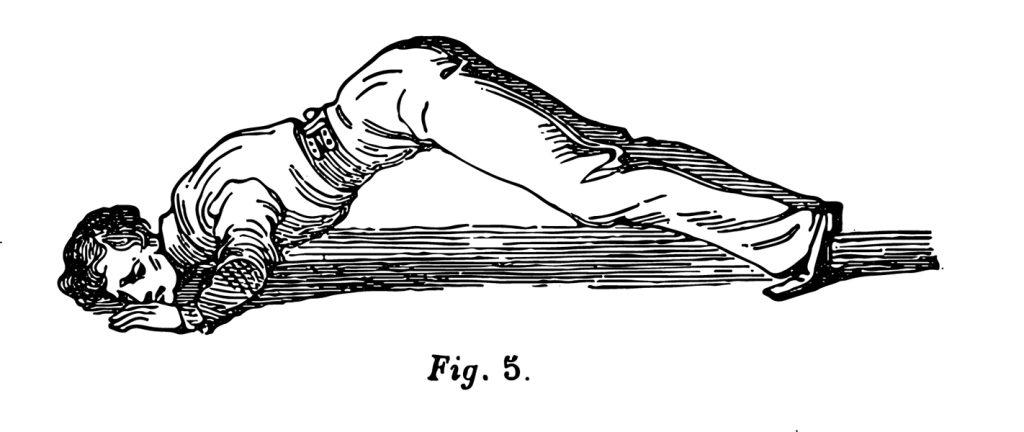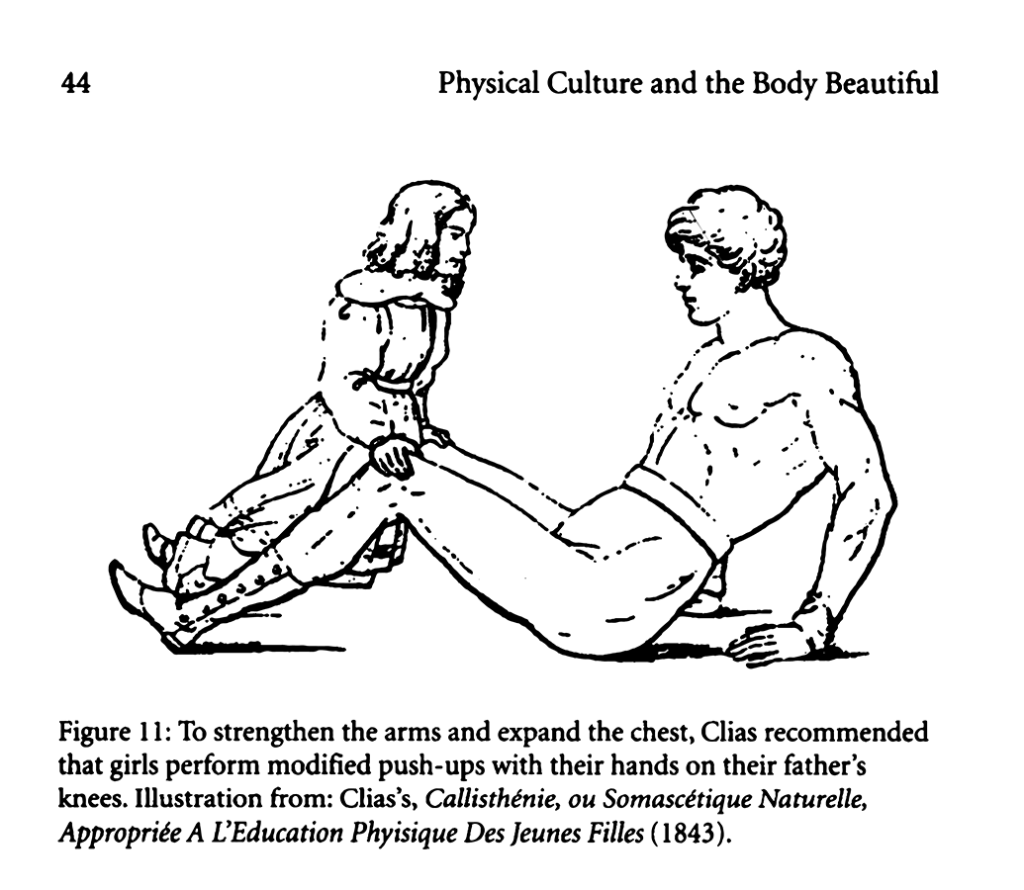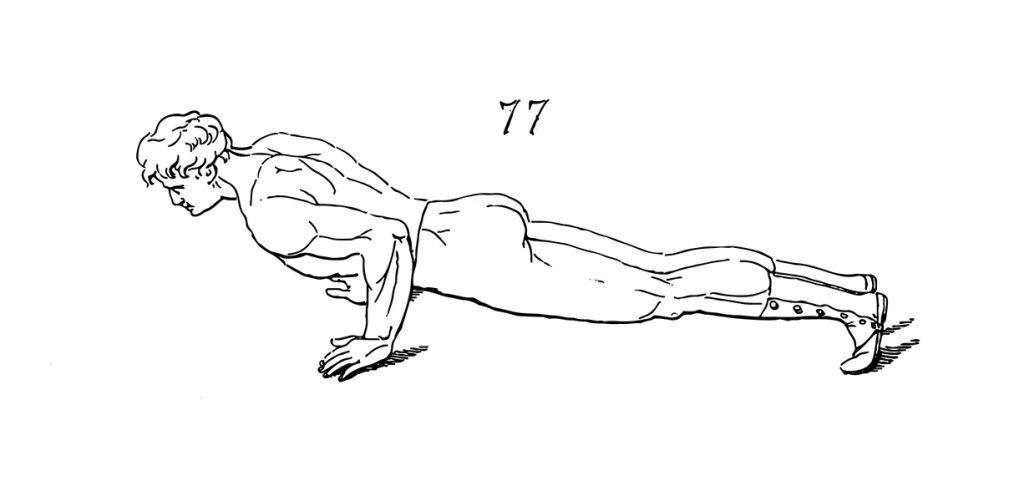One of the things I enjoy most about the Stark Center are the requests we often get for information about some aspect of the history of physical culture. Most of those requests are handled by our incredible Stark Center staff but every now and then a request will make its way to my inbox and I find myself so intrigued that I end up doing research that wasn’t planned because the question made me curious too.
This past Sunday was one of those days. I got an unexpected email from Denis Blinov, whom I’ve never met. “May I ask if you would know our earliest record of the modern push-up?” he wrote. “So far, I have yet to find a source before Eugen Sandow’s 1894 push-ups but find it very unlikely that he was the one who popularized the movement.” Denis hooked me by sending me the link to page 217 of Sandow on Physical Training that contains two photographs of Sandow by the famous photographer Napoleon Sarony. Sandow’s nude in the pictures except for a well-placed fig leaf and his feet are just slightly higher than his shoulders as he demonstrates perfect pushup technique on what looks to be a pile of leopard and polar bear skins. I’ve seen that page and the photos many times over the years, but when I looked at it on Sunday, I noticed something new. The exercise was not called a pushup. The photo’s caption read “Chest Expanding Exercise” and several pages earlier, on page 214, where the instructions appear, it was simply called “Exercise 13.”

Hmmm, I thought…. so when did we start calling it a pushup? And then, as I often tend to do, solving the puzzle became more important (and interesting) than other things I should have been doing that day. Like Lewis Carroll’s Alice, I fell down the rabbit hole, consumed for the next couple days by trying to figure out when people began doing pushups.
I began by checking the Oxford English Dictionary (OED) which tells the origins of words and gives examples of the first time they appeared in print, along with definitions. The earliest reference the OED cited for the term pushup was from 1896, but like my new friend Denis, I also believed pushups had a much longer history than Sandow’s book showed. Because of my Sandow “Aha!” moment, I knew finding early examples was probably going to be tricky, as the odds were excellent that they would not be called pushups.
So, I then turned to one of my favorite research tools, Google Book’s Ngram Viewer (https://books.google.com/ngrams/#). For those who don’t know this miraculous tool, it allows you to search all the digital books that Google has now made available online and it builds a timeline/graph showing the number of instances your search term was used in those books. So, hoping to find examples of “pushup” being used before Sandow, I entered several variations as a search term and discovered that the words pushup and push-up were used in the nineteenth century, but they were used to describe several different machine parts—not to describe exercise. “Chest Expanding Exercise” as a search term was even worse. I got no hits between 1700 and 1900––total strike out.
I then went to Google itself and searched for images and e-books from the Renaissance thinking that maybe I would find something in Mercurialis’ De Arte Gymnastica or a similar text. I had a lot of fun turning digital pages, looking at old texts on gymnastics and fencing, but I didn’t find anything definitive. I then remembered that the most famous Indian wrestler, the Great Gama was famous for doing “Dands” and other exercises at the turn of the twentieth century and so I looked next for books and old drawings from that part of the world. A Dand is a form of pushup made famous by the Kushti wrestlers of India and it is still widely practiced. You start in the “downward dog” position of Yoga—hips in the air, hands and feet on the floor, making an inverted V shape with your body—and you then lower yourself to the floor and push your chest through the arms, arching your back, raising your head high, and then returning to the starting position. I found no nineteenth-century pictures demonstrating these kinds of pushups online on Sunday, but the next day, when I went to the Stark Center, I found a fascinating reference and a drawing in Napoléon Laisné’s Gymnastique Pratique, published in 1850 in Paris, of a man doing a Dand. However, Laisné titles the exercise “Flexion de la vertébral colonne, Les Corps gravitant sur les pieds et les mains,” or, in English: “Flexion of the vertebral column with the body supported on the feet and hands.”

I was excited by this discovery, but it threw me off course for a while, as I began wondering about the connections between this Hindu-style pushup and the use of Indian clubs that had also grown popular in Europe at mid-century. Eventually, I wandered back to my main task with the increasing feeling that there was something I was overlooking. I kept thinking that I’d seen an early nineteenth-century image of a man doing a pushup and then, in an act of total serendipity, my brain pulled up another image I’d forgotten about. It was a picture of a small girl doing modified pushups by placing her hands on her father’s knees. I knew that it was from one of Swiss exercise expert Phokion Heinrich Clias’ books and using Google I soon found an 1823 English translation of his 1819 An Elementary Course of Gymnastics that was published originally in French. https://www.google.com/books/edition/An_Elementary_Course_of_Gymnastic_Exerci/t59eAAAAcAAJ?hl=en&gbpv=1&dq=%22clias%22&pg=PR7&printsec=frontcover.

But, I didn’t find the picture of the small girl and her father in that book. Instead, to my great joy, I discovered a description of the exercise I’d been searching for in a section describing how to prepare to participate in wrestling (p. 54). And, I was right in thinking that it wouldn’t be called a pushup. Clias gave it a wonderful, poetic name. He called it “Kissing the Ground in Equilibrium on the Arms and the Points of the Feet.” I smile every time I say it. I’m never calling them pushups again. And, in the back of the Stark Center’s original 1819 version there’s an illustration, a lovely line drawing depicting Clias himself (known for his muscular physique) in the perfect “Kissing the Ground” starting position.

Did I find the origin or the inventor of the push up? Absolutely not. There will never be a way to say definitively who did the first pushup, or the first squat, or the first handstand. Maybe it was a Spartan warrior, or an early Indian wrestler, or perhaps a knight of the Middle Ages who needed more strength to wield his broadsword. Someone was undoubtedly the first to fall forward to “kiss the ground” so they could build more strength in their upper body, but we will never know his or her name. All my research project really proves is that for at least the past 200 years we haven’t been doing pushups. We’ve actually been “Kissing the Ground in Equilibrium” and I feel stronger already––now that I know the real name.
Don’t Weaken,
Jan



Leave a Reply